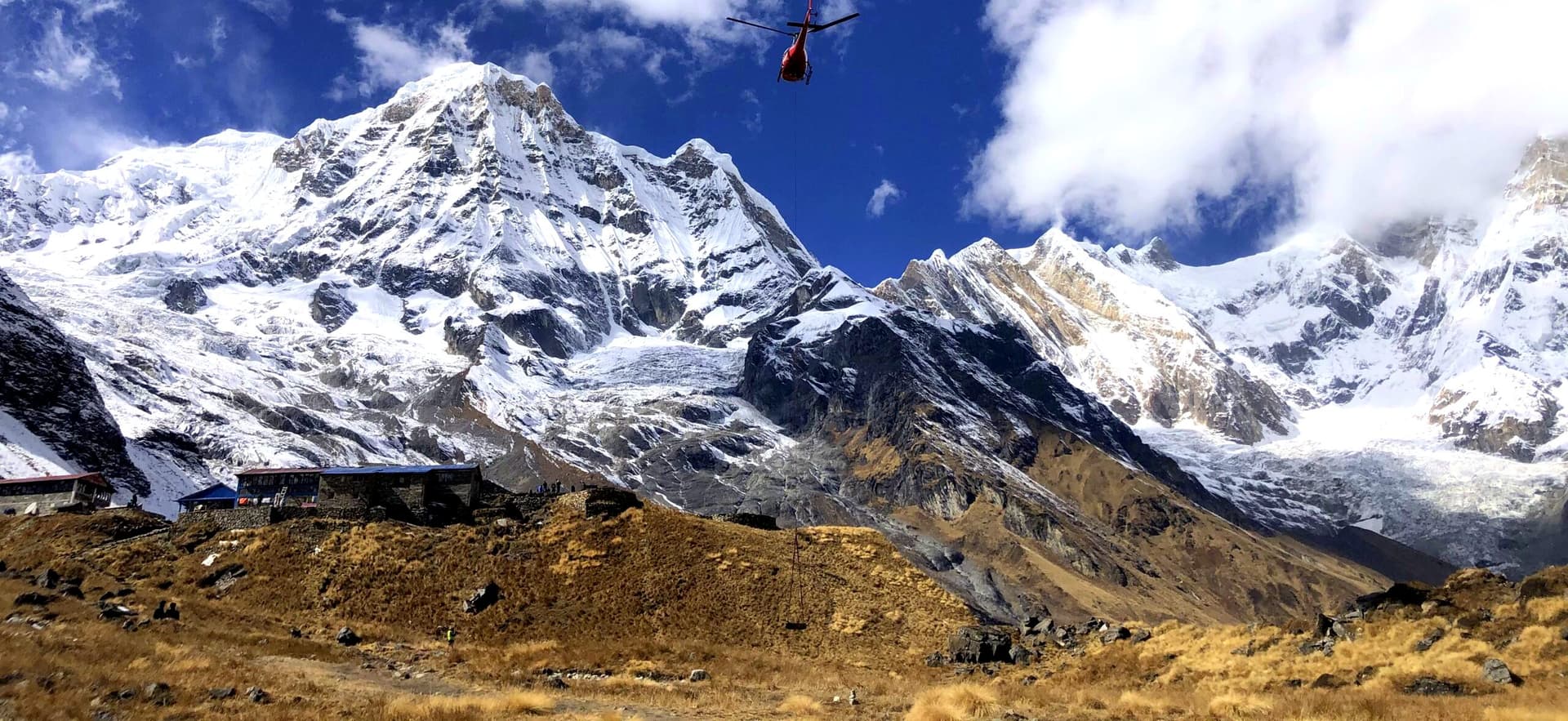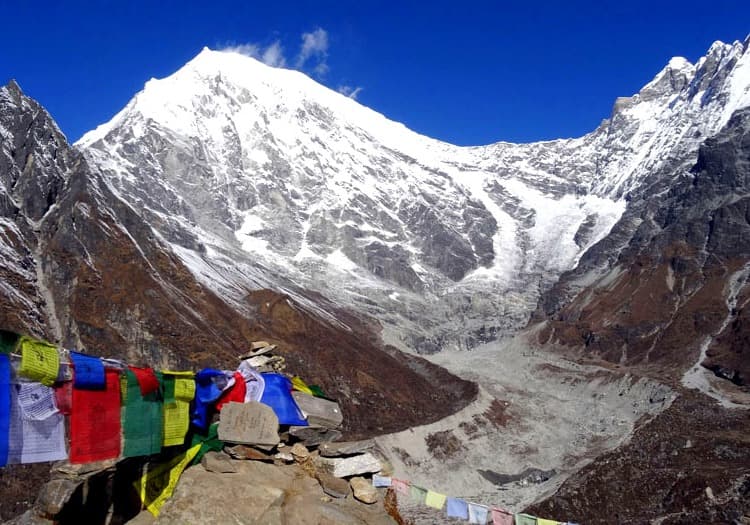For adventurous souls, the allure of a Himalayan climbing expedition often occupies a cherished spot on their bucket list. Amidst Nepal's towering peaks, a realm of possibilities awaits, each summit offering its own blend of excitement, wonder, and challenges. Among these options, two distinct and captivating choices stand out: Tent Peak (Tharpu Chuli) and Island Peak (Imja Tse). As we embark on this exploration, our aim is to not only compare but to guide you through the intricate tapestry of these peaks, assisting you in making an informed choice that resonates with your climbing aspirations.
Tent Peak (Tharpu Chuli)
With its enigmatic name and pyramid-like silhouette, Tent Peak beckons climbers to uncover its secrets in the Annapurna region of Nepal. At an elevation of 5,663 meters (18,580 feet), it offers a moderate challenge, making it an ideal playground for those with a foundation in mountaineering. But it's not just the climb that entices; it's the tranquility of its trails and the breathtaking vistas of Annapurna I, Annapurna South, and Machapuchare that paint the backdrop of this journey.
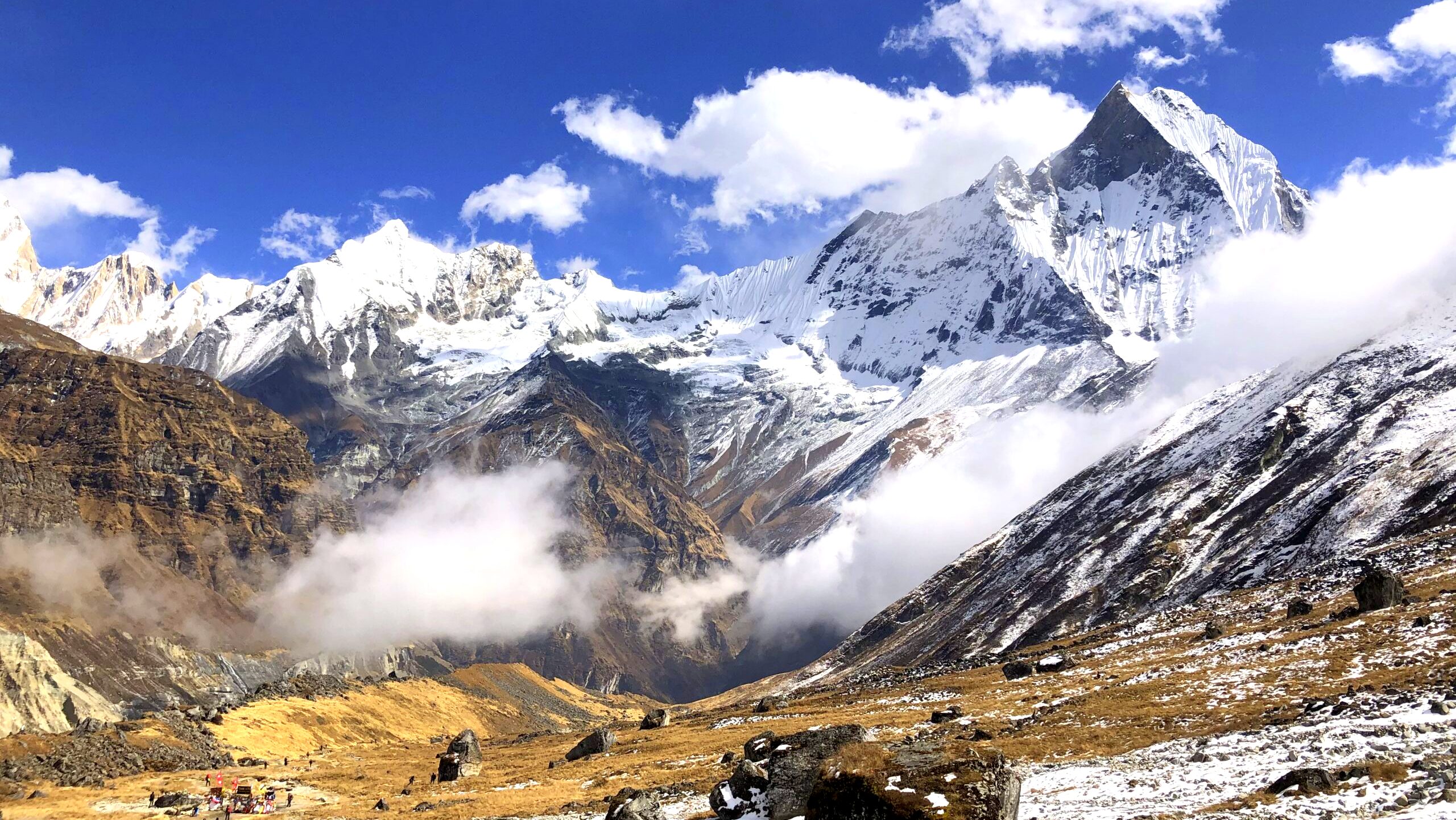
Highlights of Tent Peak (Tharpu Chuli)
- Serenity Amidst Annapurna: Embark on a trek that leads you through the enchanting Annapurna region, offering a serene and less crowded ambiance compared to other peaks.
- Annapurna Views: Feast your eyes upon panoramic vistas of the majestic Annapurna Himalayas, including Annapurna I, Annapurna South, and Machapuchare.
- Moderate Challenge: Tent Peak presents a moderately challenging ascent, perfect for climbers with basic mountaineering skills who seek a rewarding adventure.
- Cultural Immersion: Interact with local communities and gain insights into the traditional lifestyles of the Himalayan people as you traverse through charming villages.
- Tranquil Trails: Enjoy the solace of less frequented trails, allowing you to connect intimately with nature and experience the beauty of the Himalayas in peace.
- Breathtaking Summit: Stand triumphantly on the summit at 5,663 meters (18,580 feet), witnessing the world from a perspective that transcends the ordinary.
Island Peak (Imja Tse)
Meanwhile, Island Peak stands tall in the Everest region, capturing the hearts of those seeking a more technical venture. Soaring to 6,189 meters (20,305 feet), it commands a higher level of mountaineering expertise, demanding proficiency in handling glacier crossings and icy walls. Yet, the rewards are unparalleled, offering panoramic views of Everest, Lhotse, Nuptse, and Ama Dablam, the giants that define the Everest horizon.
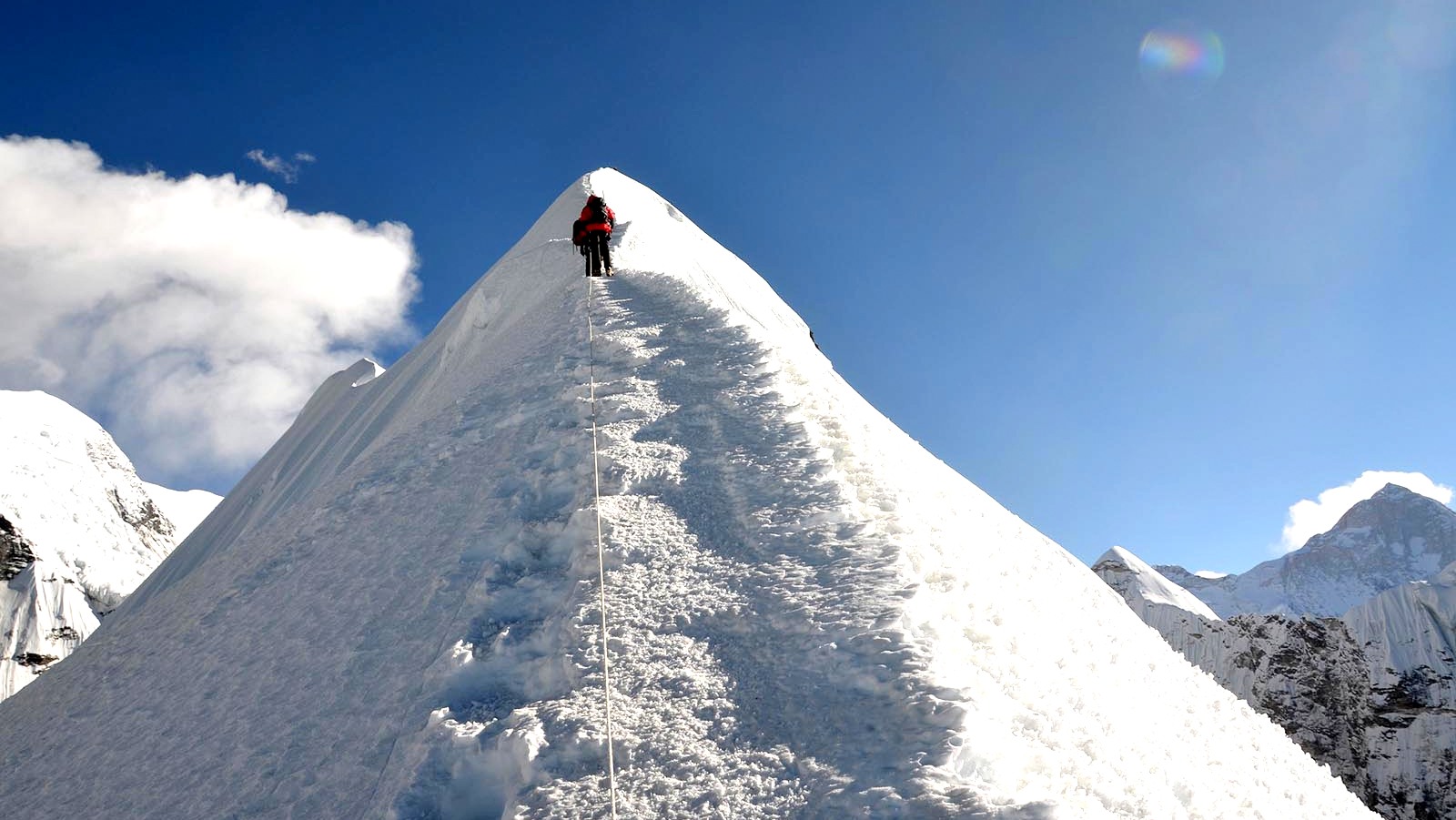
Highlights of Island Peak (Imja Tse)
- Legendary Backdrop: Trek through the iconic Everest region, with Everest, Lhotse, and Ama Dablam gracing the horizon and setting the stage for your climb.
- Advanced Challenge: Island Peak demands higher technical proficiency, attracting experienced climbers seeking to test their skills in a more complex terrain.
- Historical Significance: Ascend a peak that has been a part of mountaineering history, with routes that bear witness to the feats of legendary explorers.
- Shared Adventure: Experience the vibrant energy of the Everest region, as fellow trekkers and mountaineers from around the world embark on similar journeys.
- Awe-Inspiring Panorama: From the summit at 6,189 meters (20,305 feet), witness the glory of Everest and neighboring peaks, etching an indelible memory in your heart.
- Sherpa Culture: Immerse yourself in the rich Sherpa culture, visiting traditional villages and monasteries that reveal the heart and soul of the Everest region.
As we navigate the terrain of Tent Peak and Island Peak, remember that this isn't just a comparison; it's a conversation about dreams and the mountains that help us reach them. Whether you're drawn to Tent Peak's serene trails or Island Peak's technical challenges, the journey ahead is as unique as the fingerprints you'll leave on the icy slopes. So, let's lace up our boots and embark on this expedition through the heights, helping you discover which peak aligns best with the climber you are and the adventurer you yearn to become.
Comparative Analysis
Duration
Tent Peak (Tharpu Chuli):
- Duration Range: Climbing Tent Peak usually spans between 15 to 20 days.
- Trekking to Base Camp: The journey commences with a trek to the base camp, immersing you in the Himalayan landscapes.
- Acclimatization Days: These interludes are strategically placed to help your body adapt to the increasing altitudes, ensuring a safe ascent.
- Summit Push: The climactic summit attempt marks a pivotal moment, testing your skills and determination.
- Return Trek: After reaching the summit and savoring your achievement, you retrace your steps during the return trek.
Island Peak (Imja Tse):
- Duration Range: Island Peak climbing typically spans around 17 to 22 days.
- Trekking to Base Camp: Your adventure starts with a trek to Island Peak's base camp, revealing the beauty of the Everest region.
- Acclimatization Days: Similar to Tent Peak, acclimatization days are integral for adapting to higher altitudes safely.
- Summit Attempt: The summit attempt itself is a moment of triumph, as you conquer the challenging terrain and altitude.
- Return Trek: After standing atop the peak and soaking in the panoramic views, you journey back through the landscapes you've grown to love.
Location and Setting: Exploring the Himalayan Landscapes
Tent Peak (Tharpu Chuli): Tent Peak finds its home within the enchanting embrace of the Annapurna region, adding a touch of serenity to the journey. As you embark on its trails, you'll be greeted by the mesmerizing beauty of the Annapurna Himalayas. The tranquility that envelops Tent Peak's surroundings offers a stark contrast to the bustling world below, creating an atmosphere of calm exploration. The trails are less trodden, allowing you to connect intimately with nature and savor the peaceful ambiance that pervades the trek.
Island Peak (Imja Tse): In the Everest region, Island Peak stands tall as a beacon for adventurers seeking the majestic allure of Everest, Lhotse, and Ama Dablam. Situated amidst the iconic peaks of the Everest Himalayas, the setting of Island Peak is imbued with an air of reverence and awe. The trails exude a vibrant energy, bustling with fellow trekkers and mountaineers from around the world, creating an atmosphere of shared excitement. With each step, you'll be surrounded by the legendary landscapes that have drawn explorers and climbers for generations, adding a unique layer of historical significance to your journey.
Altitude and Difficulty: Scaling the Heights
Tent Peak (Tharpu Chuli): As you ascend Tent Peak, you'll be reaching for the sky at an elevation of 5,663 meters (18,580 feet). This altitude places you in the realm of high-altitude adventure, where the air is thinner and the environment demands a heightened level of preparation. While the climb is regarded as moderately challenging, it holds an inviting embrace for climbers with basic mountaineering skills. This makes it an excellent choice for those who are relatively new to the world of mountaineering but seek to elevate their experience to the next level.
Island Peak (Imja Tse): Island Peak soars even higher, reaching an elevation of 6,189 meters (20,305 feet). The added altitude brings with it a greater set of challenges and considerations. Climbing at these heights requires not only basic mountaineering skills but also a heightened level of technical proficiency. Glacier crossings and icy walls become part of the ascent, demanding familiarity with advanced mountaineering techniques. Island Peak beckons to those who have honed their skills and are ready to tackle more complex terrain and face the tests that come with higher altitudes.
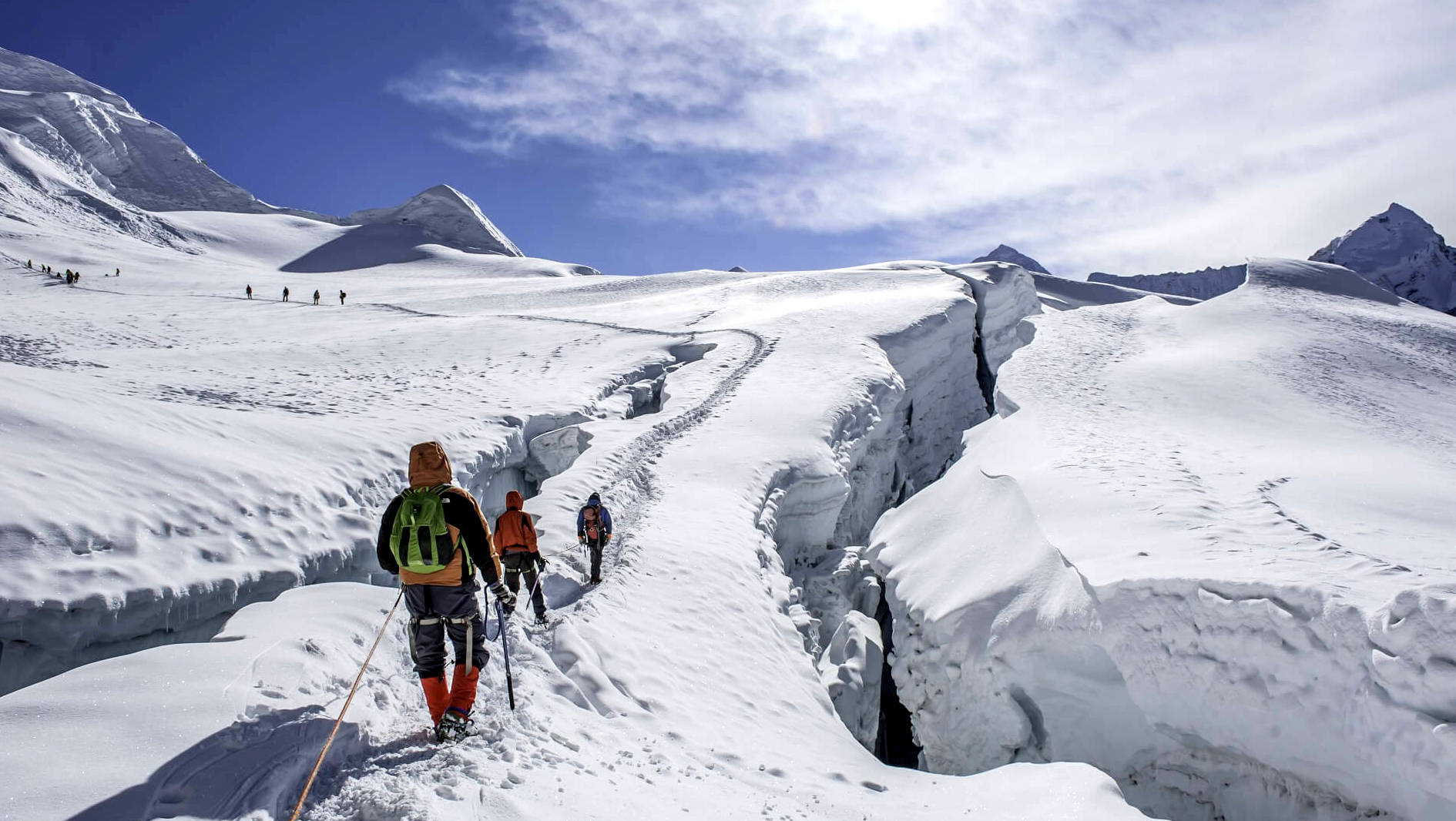
Technical Terrain: Mastering the Elements
Tent Peak (Tharpu Chuli): Embarking on the Tent Peak ascent introduces you to the enchanting realm of technical mountaineering. The journey includes sections adorned with snow and ice, calling upon your essential mountaineering skills. As you traverse these icy stretches, familiarity with techniques like using ice axes, crampons, and rope management becomes crucial. Tent Peak provides an opportunity to refine your foundational abilities, creating a bridge between basic mountaineering and more advanced expeditions.
Island Peak (Imja Tse): Island Peak's ascent takes you to the next level of technical complexity. Along the route, you'll encounter glacier crossings and icy walls that demand mastery of advanced climbing techniques. Negotiating these challenges necessitates a deeper understanding of rope work, crevasse navigation, and ice climbing. Island Peak beckons to climbers who have already embraced technical terrain and are seeking to further sharpen their expertise in the realm of high-altitude mountaineering.
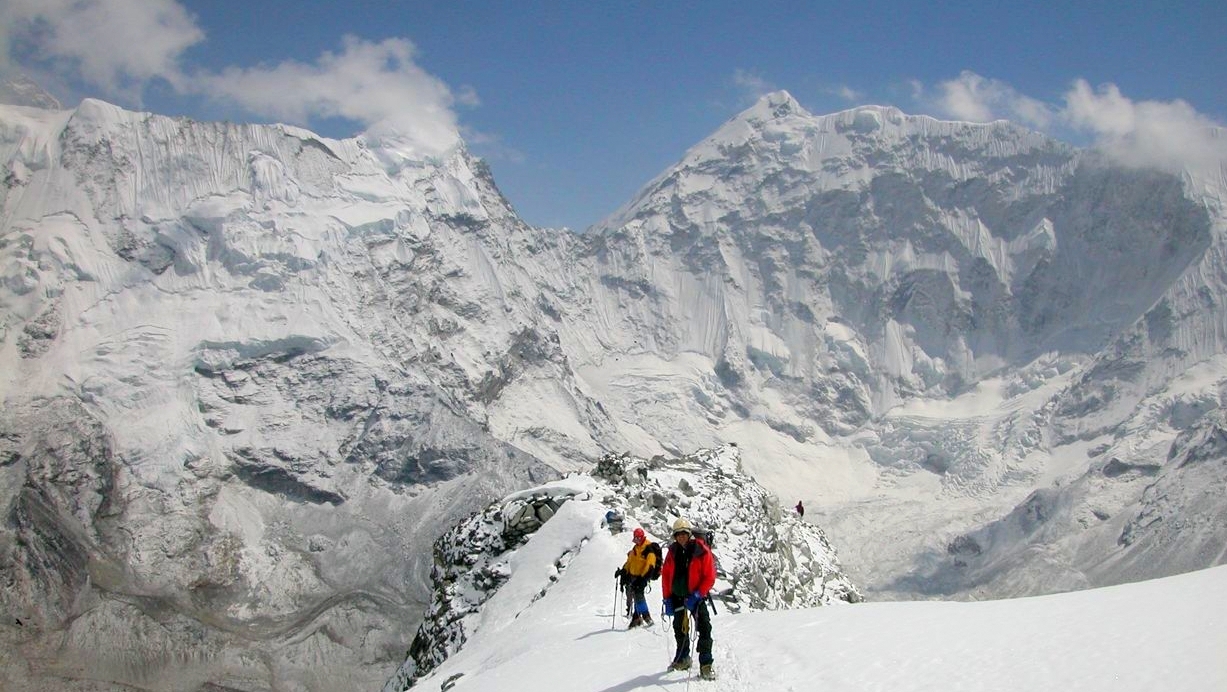
Scenery: Embracing the Himalayan Panorama
Tent Peak (Tharpu Chuli): As you ascend Tent Peak, a breathtaking tapestry of the Annapurna Himalayas unfolds before your eyes. The summit grants you panoramic views that encompass the majestic Annapurna I, the graceful Annapurna South, and the iconic Machapuchare, also known as the "Fishtail" peak. The enchanting allure of these peaks against the backdrop of the Annapurna range creates a visual symphony that resonates deep within, encapsulating the very essence of the Himalayas.
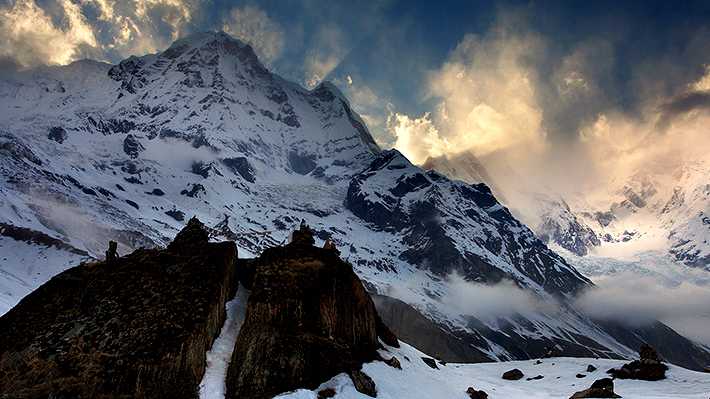
Island Peak (Imja Tse): Island Peak's summit unveils an equally captivating spectacle. The vista that stretches before you showcases the giants of the Everest Himalayan Range. Gaze upon the legendary peaks of Everest, the towering Lhotse, the majestic Nuptse, and the elegant Ama Dablam. These iconic sentinels stand as a testament to nature's grandeur and the indomitable spirit of human exploration, offering a visual feast that few experiences can rival.
Accommodation and Food: Nourishing Body and Soul
Accommodation
Tent Peak (Tharpu Chuli): Along the trek to Tent Peak, you'll find a network of teahouses and lodges scattered throughout the route. These provide cozy and comfortable resting places for trekkers. While the accommodations are basic, they offer a warm haven amidst the Himalayan wilderness. You'll have the chance to unwind, recharge, and connect with fellow trekkers in these rustic abodes.
Island Peak (Imja Tse): Island Peak's trail is also adorned with teahouses and lodges, creating a sense of camaraderie among trekkers and climbers. These accommodations serve as hubs of interaction, where stories are shared and friendships are forged. While the amenities might be simpler, the vibrant energy of the Everest region infuses the teahouses with a unique spirit that adds to the charm of your expedition.
Food
Both treks offer a range of nourishing meals to fuel your climb:
- Nepalese Cuisine: At teahouses, you'll have the chance to savor Nepalese cuisine. The staple "dal bhat," a balanced meal of rice, lentil soup, vegetables, and sometimes meat, provides energy and sustenance.
- Noodles and Pasta: Options like fried noodles and pasta dishes are commonly available, catering to various palates.
- Tea and Snacks: Teahouses offer a variety of teas, including the famed masala tea, along with biscuits, energy bars, and local treats for quick energy replenishment.
Hygiene Considerations
- While the food at teahouses is generally safe, it's recommended to prioritize cooked dishes to minimize the risk of stomach issues. Avoid consuming raw or uncooked items.
- Carry a reusable water bottle and use water purification methods or bottled water to stay hydrated and prevent waterborne illnesses.
Preparation Tips
- Pack Snacks: Carrying energy bars, nuts, and snacks is advisable to supplement your meals, especially during the challenging climb to higher altitudes.
- Dietary Restrictions: Inform your trekking agency about any dietary restrictions or allergies in advance, so they can make necessary arrangements.
- Warmth: Nights can be cold, particularly at higher altitudes. Consider carrying a lightweight sleeping bag liner for added warmth.
- Trekking Agency Support: Your chosen trekking agency typically handles accommodation and meal arrangements, ensuring you have a comfortable stay and proper nutrition throughout your climb.
The accommodations and food along the trails of Tent Peak and Island Peak blend comfort with the unique charm of the Himalayas. Teahouses offer a space to rest, refuel, and connect with fellow adventurers, while the flavors of Nepalese cuisine nourish both body and soul. Your trek becomes a holistic experience, combining physical challenge with cultural exploration.
Best Season: Timing Your Himalayan Odyssey
Tent Peak (Tharpu Chuli): The optimal windows for conquering Tent Peak align with the enchanting seasons of spring (March to May) and autumn (September to November). During these periods, the Himalayan landscape awakens from its slumber, unveiling a symphony of colors and contrasts. Spring bathes the trails in blooming rhododendrons and lush vegetation, while autumn carpets them with golden hues. The weather is relatively stable, with clear skies gracing your ascent and granting unobstructed vistas of the surrounding peaks.
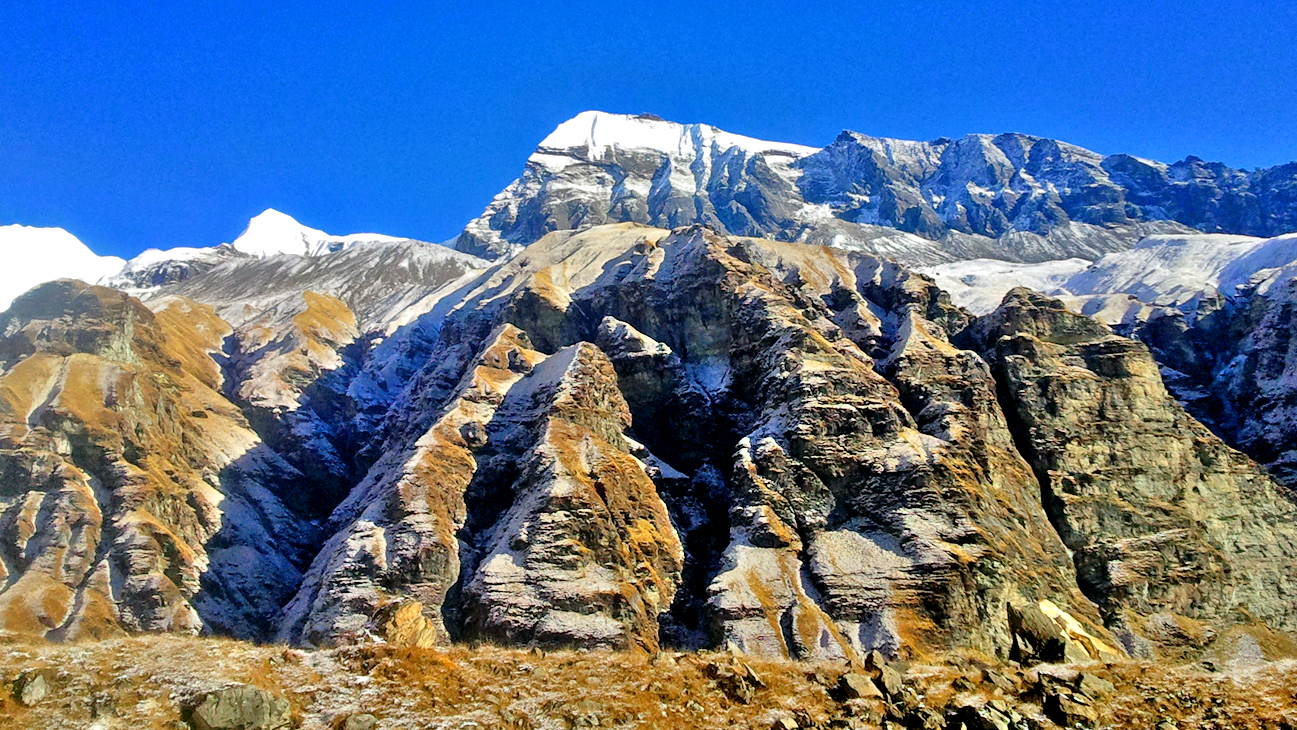
Island Peak (Imja Tse): Island Peak echoes the sentiment, with spring (March to May) and autumn (September to November) standing as the prime seasons for your Everest region adventure. As the same vibrant seasons embrace the trails, you'll find yourself amidst the splendor of blooming flora in spring and the stunning clarity of autumnal landscapes. The climatic stability of these seasons ensures safer and more enjoyable climbing conditions, enhancing your experience atop Island Peak.
Trekking Permits: Navigating the Administrative Landscape
Tent Peak (Tharpu Chuli)
- Permits Required: Annapurna Conservation Area Permit (ACAP) and Trekkers' Information Management System (TIMS) card.
- ACAP: The Annapurna Conservation Area Permit grants you access to the Annapurna region, encompassing Tent Peak's trail and surrounding areas.
- TIMS Card: The Trekkers' Information Management System card ensures your safety and provides valuable information to authorities.
Island Peak (Imja Tse)
- Permits Required: Sagarmatha National Park Entry Permit and Trekkers' Information Management System (TIMS) card.
- Sagarmatha National Park Entry Permit: This permit is essential for entering the Sagarmatha National Park, home to Island Peak and the iconic Everest region.
- TIMS Card: The TIMS card aids in tracking trekkers' movements and providing necessary information to authorities.
Tent Peak vs Island Peak - Which Peak to Choose for Climbing?: Paving Your Himalayan Path
When standing at the crossroads of choosing between Tent Peak and Island Peak, you're embarking on a journey that aligns with your climbing aspirations, skills, and the very essence of your adventure. Here's a closer look at the factors guiding your decision:
Tent Peak (Tharpu Chuli):
- Balanced Challenge: Tent Peak is an excellent choice for those stepping into the realm of Himalayan climbing. It offers a moderate challenge that's well-suited for climbers with basic mountaineering skills.
- Tranquil Surroundings: The serene trails of Tent Peak wind through the Annapurna region, enveloping you in a peaceful and less crowded ambiance.
- Gateway to the Heights: Opt for Tent Peak if you're seeking a stepping stone toward higher-altitude mountaineering, gaining valuable experience in a stunning setting.
Island Peak (Imja Tse):
- Advanced Ascent: Island Peak beckons to those ready to take on more advanced technical demands. Glacier crossings and icy walls call for seasoned climbers with advanced mountaineering skills.
- Everest's Iconic Panorama: The allure of Island Peak lies in its reward – the breathtaking panorama of Everest, Lhotse, and other legendary peaks. This awe-inspiring backdrop accompanies your climb.
- For the Experienced: If you're prepared to face the challenges of a more intricate and demanding climb, Island Peak offers an avenue for those experienced in the art of mountaineering.
Ultimately, your choice between Tent Peak and Island Peak mirrors the adventurer within you. It reflects the aspirations you harbor, the skills you possess, and the heights you're ready to conquer. Each peak offers a unique narrative, and your decision is a chapter that adds to the story of your Himalayan exploration. Whether you choose the tranquil path of Tent Peak or the more challenging ascent of Island Peak, your journey will be one of growth, discovery, and the undeniable allure of the mountains.
Climbing Checklists: Preparing for Peak Success
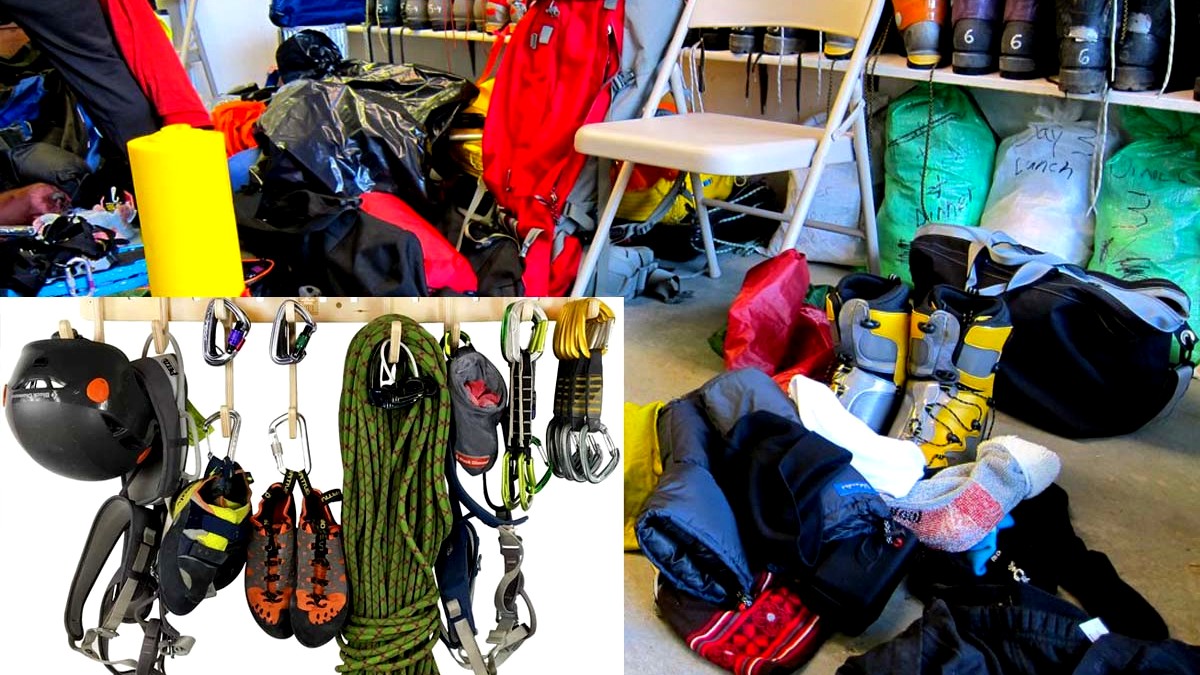
Before You Go
- Physical Fitness: Ensure you're in good physical condition with regular cardiovascular and strength training.
- Research and Training: Familiarize yourself with basic mountaineering techniques and consider taking a training course if needed.
- Gear and Equipment: Prepare your climbing gear, including clothing, footwear, harness, ice axe, crampons, helmet, and more.
- Health Check: Consult a medical professional for a thorough health check-up, and discuss any pre-existing conditions or concerns.
- Travel Insurance: Purchase comprehensive travel insurance that covers high-altitude climbing and related risks.
Gear and Equipment
- Clothing: Pack appropriate layers for varying conditions, including moisture-wicking base layers, insulating layers, and waterproof outerwear.
- Footwear: Sturdy mountaineering boots with crampon compatibility are crucial.
- Climbing Gear: Ice axe, crampons, helmet, harness, prusik cords, and carabiners are essential for technical sections.
- Sleeping Gear: Sleeping bag suitable for sub-zero temperatures, sleeping pad, and a liner for added warmth.
- Accessories: Gloves, headlamp, sunglasses, gaiters, and trekking poles are invaluable additions.
Acclimatization
- Gradual Ascent: Plan your itinerary to include gradual altitude gains with acclimatization days.
- Hydration: Stay hydrated throughout the climb to mitigate the risk of altitude sickness.
- Nutrition: Pack energy-rich snacks and prioritize a balanced diet to maintain your strength.
Safety
- Altitude Sickness: Monitor your own and your team's health, and descend if symptoms of altitude sickness worsen.
- Communication: Carry a reliable communication device, such as a satellite phone or a two-way radio.
- Guides and Crew: If climbing independently, ensure you have a team with diverse skills and expertise.
Permits and Documentation
- Climbing Permits: Obtain the necessary climbing permits for your chosen peak.
- Identification: Carry a valid passport, climbing permits, and any required identification.
Environmental Responsibility
- Leave No Trace: Respect the mountains by adhering to "Leave No Trace" principles and minimizing your environmental impact.
Training and Mental Preparedness
- Physical Training: Maintain a regular training routine that includes cardiovascular exercise and strength training.
- Mental Resilience: Prepare mentally for the challenges and uncertainties of high-altitude climbing.
Weather and Conditions
- Weather Forecast: Stay updated on the weather forecast and be prepared for changing conditions.
Emergency Plan
- Emergency Contacts: Share your climbing itinerary and emergency contacts with reliable sources.
- Evacuation Plan: Familiarize yourself with the evacuation procedures and routes in case of emergencies.
Final Checks
- Pack Check: Double-check all gear, ensuring nothing is forgotten.
- Readiness: Confirm your physical and mental readiness for the climb.
Embarking on the Climb:
Remember that every climb is unique, and flexibility is key. Be prepared to adapt to changing conditions and make decisions prioritizing safety above all else. As you ascend towards the peak, carry with you the spirit of adventure and a deep respect for the mountains.
Frequently Asked Questions (FAQs) for Tent Peak vs Island Peak
Q. Which peak offers a more challenging climb, Tent Peak or Island Peak?
A. Tent Peak is considered moderately challenging and suitable for climbers with basic mountaineering skills. Island Peak, on the other hand, demands more advanced technical skills and experience due to its greater altitude and technical terrain.
Q. What is the maximum altitude reached on Tent Peak and Island Peak?
A. Tent Peak reaches an altitude of 5,663 meters (18,580 feet), while Island Peak's summit stands at 6,189 meters (20,305 feet).
Q. What are the main highlights of each climb?
A. Tent Peak offers serene trails in the Annapurna region with stunning Annapurna views. Island Peak presents a more technically demanding climb alongside the iconic backdrop of Everest, Lhotse, and Ama Dablam.
Q. Can I combine climbing these peaks with other treks?
A. Yes, both peaks can be combined with other treks. Island Peak is often combined with the Everest Base Camp trek.
Q. Which peak has more beautiful scenery and views?
A. Both peaks offer breathtaking views, but the choice depends on whether you prefer the allure of Annapurna's landscapes (Tent Peak) or the grandeur of Everest's surroundings (Island Peak).
Q. Which peak is more suitable for beginners?
A. Tent Peak is more beginner-friendly due to its less technical terrain and lower altitude. Island Peak requires prior climbing experience and more advanced skills.
Q. What's the best time to climb Tent Peak and Island Peak?
A. Both peaks are best climbed in the spring (March to May) and autumn (September to November) seasons when weather is stable and skies are clear.
Q. Are these climbs suitable for solo climbers or groups?
A. While solo climbing is possible for experienced climbers, it's recommended to climb with a group or guide for safety reasons.
Q. What permits are required for climbing Tent Peak and Island Peak?
A. For Tent Peak, permits include the Annapurna Conservation Area Permit (ACAP) and the Trekkers' Information Management System (TIMS) card. For Island Peak, you need the Sagarmatha National Park Entry Permit and TIMS card.
Q. Which peak offers a more culturally immersive experience?
A. Both peaks provide opportunities for cultural interactions with local communities. Tent Peak in the Annapurna region offers insights into Gurung culture, while Island Peak in the Everest region is rich in Sherpa traditions.
Q. How do I ensure responsible trekking and climbing?
A. Adhere to "Leave No Trace" principles, respect local customs, and prioritize environmental sustainability throughout your journey.
Q. Can I rent climbing equipment locally in Nepal?
A. Basic equipment like sleeping bags and down jackets can be rented, but for technical gear, it's recommended to bring your own.
Q. Which climb is more accessible in terms of logistics?
A. Tent Peak is relatively accessible from Pokhara, while Island Peak requires a flight to Lukla and a trek to the Everest region.
Q. Can I climb these peaks during the monsoon season?
A. Climbing during the monsoon season (June to August) is not recommended due to heavy rainfall, poor visibility, and increased risks.
8000m Mountain Expeditions
We Offer the Following similar 8000m Mountain Expedition in Nepal
Mt Everest Expedition (8848.86 m)
Manaslu Expedition (8,163 m)
Makalu Expedition (8,463m)
Kanchenjunga Expedition (8,586 m)
Lhotse Expedition (8,516 m)
We also offer peak climbing expeditions in Nepal at altitudes of 7000 and 6000 meters.
7000 M Peaks for Climbing and Expedition
Gangapurna Expedition (7,455 m)
Pumori Expedition (7,145 m)
Tilicho Peak Expedition (7,134 m)
Annapurna South Expedition (7,219 m)
6000 M Peaks for Climbing and Expedition in Nepal
Mt Ama Dablam Expedition (6,812 m)
Island Peak Expedition (6,160 m)
Mera Peak Climbing (6,476 m)
Chulu West Peak Climbing (6,419 m)
Pisang Peak Climbing (6,091 m)
Singu Chuli Peak Climbing (6,501 m)
Island Peak Climbing with Everest Base Camp Trek
Lobuche Peak Climbing with Everest Base Camp
If you need any further information, please contact us, Email: [email protected], Phone: +977- 985 100 5129 (WhatsApp)

